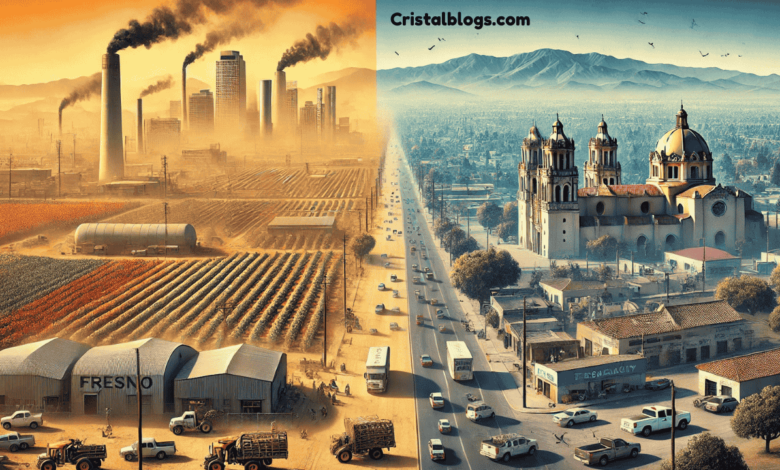Fresno vs Oaxaca City Comparison Pollution: A Deep Dive into Air Quality and Environmental Challenges

When it comes to air quality, pollution is a global issue affecting cities of all sizes, from industrial hubs to cultural capital. This article compares two cities — Fresno, a major urban area in California’s Central Valley, and Oaxaca City in southern Mexico. Though vastly different in size, geography, and economy, both cities face significant pollution challenges. Understanding each city’s sources, impacts, and mitigation efforts can help us learn more about how urbanization and geography influence air quality.
Introduction: Pollution in Urban Environments
Air pollution is a serious health concern worldwide, and cities often serve as the epicentre of pollution due to factors like industrial activities, transportation, and population density. While larger cities like Los Angeles or Mexico City receive more media attention, smaller cities like Fresno and Oaxaca City face unique pollution challenges. In this article, we will delve into a comprehensive Fresno vs Oaxaca City comparison pollution, examining the primary pollutants, the sources of pollution, and the impacts on the health of their populations.
Air Quality Overview in Fresno and Oaxaca City
Fresno: A Struggle with Smog and Particulate Matter
Fresno, located in California’s Central Valley, has long been notorious for its poor air quality. According to the American Lung Association’s State of the Air report, Fresno consistently ranks as one of the cities with the worst air quality in the United States. The major pollutants in Fresno are ozone (smog) and particulate matter (PM2.5). These pollutants often exceed the National Ambient Air Quality Standards (NAAQS), leading to severe health risks for the residents, including respiratory diseases and cardiovascular problems.
Fresno’s geographic location in a valley surrounded by mountains traps air pollution. This geographical feature, combined with hot summer temperatures, exacerbates the effects of pollution. The region is often stagnant, and as a result, pollutants like smog have limited dispersion. Ozone levels can spike during the summer due to vehicular emissions, agricultural activities, and industrial sources.
Oaxaca City: Better Air Quality, but Still Facing Challenges
On the other hand, Oaxaca City generally experiences better air quality compared to major industrial cities like Mexico City or Fresno. Oaxaca is located in a more elevated, mountainous region and enjoys more natural dispersion of pollutants. However, this does not mean the city is without its pollution problems. The primary sources of pollution in Oaxaca are vehicle emissions and dust, especially during the dry season when particulate pollution becomes a concern.
Despite having relatively cleaner air compared to other major cities in Mexico, air quality can still deteriorate, particularly during peak tourist seasons or when local biomass burning for cooking occurs in rural areas surrounding the city. Oaxaca’s government has started taking initiatives to monitor and improve air quality, but challenges remain, particularly with the rising number of vehicles on the roads.
Key Sources of Pollution in Fresno and Oaxaca City
Understanding the sources of pollution is essential for addressing the issue effectively. Let’s examine the main contributors to air pollution in Fresno and Oaxaca City.
Fresno: Agriculture, Traffic, and Climate
Agricultural Activities: Fresno is at the heart of one of the largest agricultural regions in the United States. As a result, agricultural activities are one of the leading contributors to air pollution. The dust from farming and the use of pesticides and fertilizers can significantly increase particulate matter (PM2.5) levels in the air.
Vehicle Emissions: The city’s high traffic levels, including significant truck traffic along major highways, contribute heavily to ozone and particulate matter levels. As a heavily trafficked area, particularly during the farming season, Fresno’s roadways become congested, increasing vehicle emissions.
Climate and Geography: Fresno’s location in the Central Valley creates inversion layers that trap pollutants near the ground. During the summer, this stagnant air creates perfect conditions for ozone formation, which worsens air quality combined with hot temperatures.
Oaxaca City: Vehicles, Dust, and Biomass Burning
Vehicle Emissions: Oaxaca City’s rapid urbanization has steadily increased the number of vehicles on the road. Vehicle emissions are one of the major contributors to pollution in the city. Older vehicles, often without proper emissions control systems, can release many pollutants, particularly in urban areas.
Dust and Construction: Due to Oaxaca’s dry climate and dusty environment, particulate matter can accumulate in the air. Construction activities in the city also contribute to dust pollution, which can degrade air quality during certain seasons.
Biomass Burning: In rural areas surrounding Oaxaca, many people rely on biomass burning (such as wood and crop residues) for cooking. This form of combustion can release harmful particulate matter into the atmosphere, which can drift into the city and worsen air quality during certain times of the year.
Health Impacts of Pollution in Fresno and Oaxaca City
Fresno: Respiratory Issues and Heart Disease
The air quality in Fresno has direct consequences on the health of its residents. Due to high levels of ozone and particulate matter, people in Fresno are at a higher risk for developing respiratory diseases, including asthma and chronic obstructive pulmonary disease (COPD). Studies have shown that children in Fresno have a higher rate of asthma compared to other regions in California, with over 30% of Fresno’s population experiencing respiratory health issues due to air pollution.
The air quality also contributes to cardiovascular problems. Long-term exposure to polluted air can lead to an increased risk of heart disease and stroke. These health concerns are exacerbated by Fresno’s socioeconomic disparities, with low-income communities often being more affected by air pollution due to their proximity to industrial and agricultural areas.
Oaxaca City: Mild but Present Health Risks
Although Oaxaca City generally enjoys better air quality, pollution still poses a health risk, particularly for vulnerable populations such as children, the elderly, and individuals with pre-existing health conditions. Respiratory issues like bronchitis and asthma can arise from vehicle emissions and particulate matter during the dry season.
People living in rural areas who rely on biomass burning for cooking are also at risk of exposure to toxic fumes, which can contribute to chronic respiratory diseases over time. Dust pollution during the dry season can exacerbate health problems for people already dealing with lung conditions.
Efforts to Mitigate Pollution in Fresno and Oaxaca City
Fresno: Striving for Clean Air Amid Challenges
To combat its pollution problem, Fresno has implemented several air quality management measures over the years. These include:
- Limiting agricultural burning: The California Air Resources Board (CARB) has enforced restrictions on open-field burning, one of the region’s most significant contributors to air pollution.
- Cleaner vehicles: The city has promoted using electric vehicles (EVs) and carpool lanes to reduce traffic emissions.
- Public health campaigns: Local health organizations run campaigns to raise awareness about air pollution and encourage practices that can help reduce exposure, such as staying indoors on high-pollution days.
Despite these efforts, Fresno still struggles with poor air quality, and more needs to be done to address the underlying sources of pollution.
Oaxaca City: Green Initiatives and Sustainable Urban Planning
Oaxaca City has also taken steps to improve air quality on a smaller scale. The city’s efforts include the following:
- Promoting electric public transportation: Oaxaca is encouraging the use of electric buses and other sustainable modes of transportation to reduce vehicle emissions.
- Dust Management: The local government has initiated programs to control dust pollution, especially during construction projects, using water sprays to dampen the ground.
- Sustainable cooking alternatives: In rural areas, there are efforts to promote clean cookstoves to reduce the health impacts of biomass burning.
Conclusion: Key Differences in Pollution Between Fresno and Oaxaca City
In conclusion, the Fresno vs Oaxaca City comparison pollution highlights the varying levels and sources of pollution in these two cities. While Fresno grapples with severe air quality issues caused by agricultural activities, vehicle emissions, and its valley geography, Oaxaca City experiences relatively better air quality. Still, it faces challenges with vehicle emissions, dust, and biomass burning.




